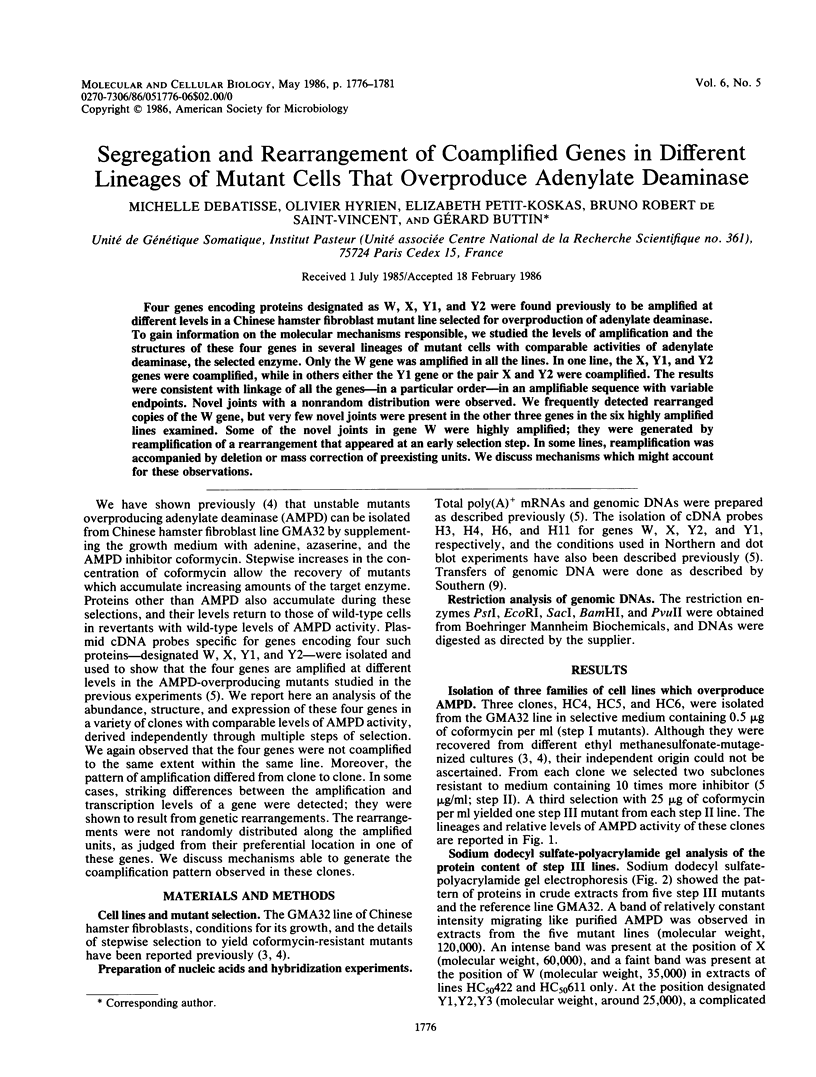Segregation and rearrangement of coamplified genes in different lineages of mutant cells that overproduce adenylate deaminase (original) (raw)
Abstract
Four genes encoding proteins designated as W, X, Y1, and Y2 were found previously to be amplified at different levels in a Chinese hamster fibroblast mutant line selected for overproduction of adenylate deaminase. To gain information on the molecular mechanisms responsible, we studied the levels of amplification and the structures of these four genes in several lineages of mutant cells with comparable activities of adenylate deaminase, the selected enzyme. Only the W gene was amplified in all the lines. In one line, the X, Y1, and Y2 genes were coamplified, while in others either the Y1 gene or the pair X and Y2 were coamplified. The results were consistent with linkage of all the genes--in a particular order--in an amplifiable sequence with variable endpoints. Novel joints with a nonrandom distribution were observed. We frequently detected rearranged copies of the W gene, but very few novel joints were present in the other three genes in the six highly amplified lines examined. Some of the novel joints in gene W were highly amplified; they were generated by reamplification of a rearrangement that appeared at an early selection step. In some lines, reamplification was accompanied by deletion or mass correction of preexisting units. We discuss mechanisms which might account for these observations.

Images in this article
Selected References
These references are in PubMed. This may not be the complete list of references from this article.
- Ardeshir F., Giulotto E., Zieg J., Brison O., Liao W. S., Stark G. R. Structure of amplified DNA in different Syrian hamster cell lines resistant to N-(phosphonacetyl)-L-aspartate. Mol Cell Biol. 1983 Nov;3(11):2076–2088. doi: 10.1128/mcb.3.11.2076. [DOI] [PMC free article] [PubMed] [Google Scholar]
- Beverley S. M., Coderre J. A., Santi D. V., Schimke R. T. Unstable DNA amplifications in methotrexate-resistant Leishmania consist of extrachromosomal circles which relocalize during stabilization. Cell. 1984 Sep;38(2):431–439. doi: 10.1016/0092-8674(84)90498-7. [DOI] [PubMed] [Google Scholar]
- Debatisse M., Berry M., Buttin G. Stepwise isolation and properties of unstable Chinese hamster cell variants that overproduce adenylate deaminase. Mol Cell Biol. 1982 Nov;2(11):1346–1353. doi: 10.1128/mcb.2.11.1346. [DOI] [PMC free article] [PubMed] [Google Scholar]
- Debatisse M., Berry M., Buttin G. The potentiation of adenine toxicity to Chinese hamster cells by coformycin: suppression in mutants with altered regulation of purine biosynthesis or increased adenylate-deaminase activity. J Cell Physiol. 1981 Jan;106(1):1–11. doi: 10.1002/jcp.1041060102. [DOI] [PubMed] [Google Scholar]
- Debatisse M., de Saint Vincent B. R., Buttin G. Expression of several amplified genes in an adenylate-deaminase overproducing variant of Chinese hamster fibroblasts. EMBO J. 1984 Dec 20;3(13):3123–3127. doi: 10.1002/j.1460-2075.1984.tb02268.x. [DOI] [PMC free article] [PubMed] [Google Scholar]
- Federspiel N. A., Beverley S. M., Schilling J. W., Schimke R. T. Novel DNA rearrangements are associated with dihydrofolate reductase gene amplification. J Biol Chem. 1984 Jul 25;259(14):9127–9140. [PubMed] [Google Scholar]
- Nunberg J. H., Kaufman R. J., Schimke R. T., Urlaub G., Chasin L. A. Amplified dihydrofolate reductase genes are localized to a homogeneously staining region of a single chromosome in a methotrexate-resistant Chinese hamster ovary cell line. Proc Natl Acad Sci U S A. 1978 Nov;75(11):5553–5556. doi: 10.1073/pnas.75.11.5553. [DOI] [PMC free article] [PubMed] [Google Scholar]
- Roberts J. M., Axel R. Gene amplification and gene correction in somatic cells. Cell. 1982 May;29(1):109–119. doi: 10.1016/0092-8674(82)90095-2. [DOI] [PubMed] [Google Scholar]
- Southern E. M. Detection of specific sequences among DNA fragments separated by gel electrophoresis. J Mol Biol. 1975 Nov 5;98(3):503–517. doi: 10.1016/s0022-2836(75)80083-0. [DOI] [PubMed] [Google Scholar]
- Subramani S., Rubnitz J. Recombination events after transient infection and stable integration of DNA into mouse cells. Mol Cell Biol. 1985 Apr;5(4):659–666. doi: 10.1128/mcb.5.4.659. [DOI] [PMC free article] [PubMed] [Google Scholar]